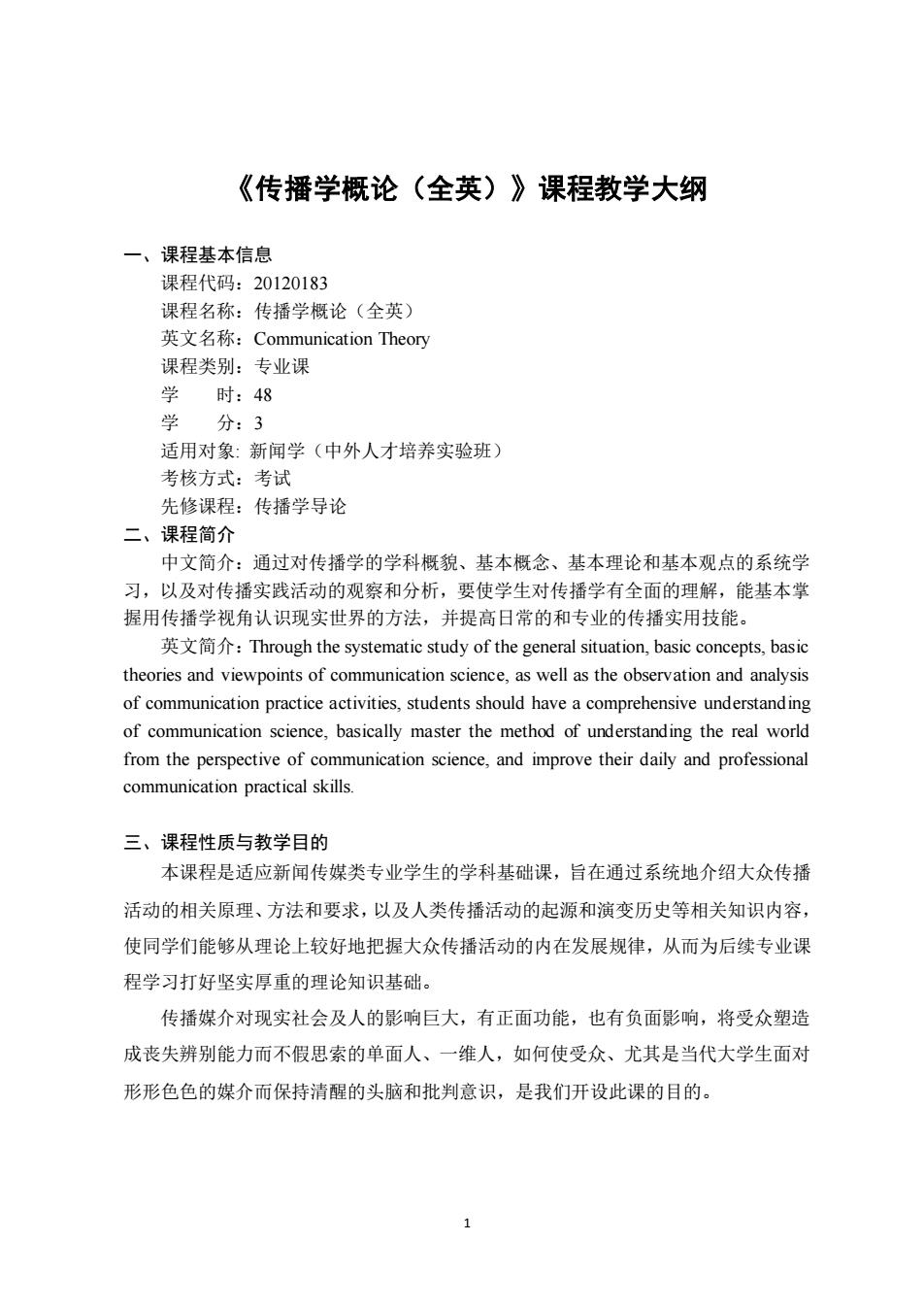
《传播学概论(全英)》课程教学大纲 一、课程基本信息 课程代码:20120183 课程名称:传播学概论(全英) 英文名称:Communication Theory 课程类别:专业课 时:48 学分:3 适用对象:新闻学(中外人才培养实验班) 考核方式:考试 先修课程:传播学导论 二、课程简介 中文简介:通过对传播学的学科概貌、基本概念、基本理论和基本观点的系统学 习,以及对传播实践活动的观察和分析,要使学生对传播学有全面的理解,能基本掌 握用传播学视角认识现实世界的方法,并提高日常的和专业的传播实用技能。 英文简介:Through the systematic study of the general situation,.basic concepts,.basic theories and viewpoints of communication science,as well as the observation and analysis of communication practice activities,students should have a comprehensive understanding of communication science,basically master the method of understanding the real world from the perspective of communication science,and improve their daily and professional communication practical skills. 三、课程性质与教学目的 本课程是适应新闻传媒类专业学生的学科基础课,旨在通过系统地介绍大众传播 活动的相关原理、方法和要求,以及人类传播活动的起源和演变历史等相关知识内容, 使同学们能够从理论上较好地把握大众传播活动的内在发展规律,从而为后续专业课 程学习打好坚实厚重的理论知识基础。 传播媒介对现实社会及人的影响巨大,有正面功能,也有负面影响,将受众塑造 成丧失辨别能力而不假思索的单面人、一维人,如何使受众、尤其是当代大学生面对 形形色色的媒介而保持清醒的头脑和批判意识,是我们开设此课的目的
1 《传播学概论(全英)》课程教学大纲 一、课程基本信息 课程代码:20120183 课程名称:传播学概论(全英) 英文名称:Communication Theory 课程类别:专业课 学 时:48 学 分:3 适用对象: 新闻学(中外人才培养实验班) 考核方式:考试 先修课程:传播学导论 二、课程简介 中文简介:通过对传播学的学科概貌、基本概念、基本理论和基本观点的系统学 习,以及对传播实践活动的观察和分析,要使学生对传播学有全面的理解,能基本掌 握用传播学视角认识现实世界的方法,并提高日常的和专业的传播实用技能。 英文简介:Through the systematic study of the general situation, basic concepts, basic theories and viewpoints of communication science, as well as the observation and analysis of communication practice activities, students should have a comprehensive understanding of communication science, basically master the method of understanding the real world from the perspective of communication science, and improve their daily and professional communication practical skills. 三、课程性质与教学目的 本课程是适应新闻传媒类专业学生的学科基础课,旨在通过系统地介绍大众传播 活动的相关原理、方法和要求,以及人类传播活动的起源和演变历史等相关知识内容, 使同学们能够从理论上较好地把握大众传播活动的内在发展规律,从而为后续专业课 程学习打好坚实厚重的理论知识基础。 传播媒介对现实社会及人的影响巨大,有正面功能,也有负面影响,将受众塑造 成丧失辨别能力而不假思索的单面人、一维人,如何使受众、尤其是当代大学生面对 形形色色的媒介而保持清醒的头脑和批判意识,是我们开设此课的目的
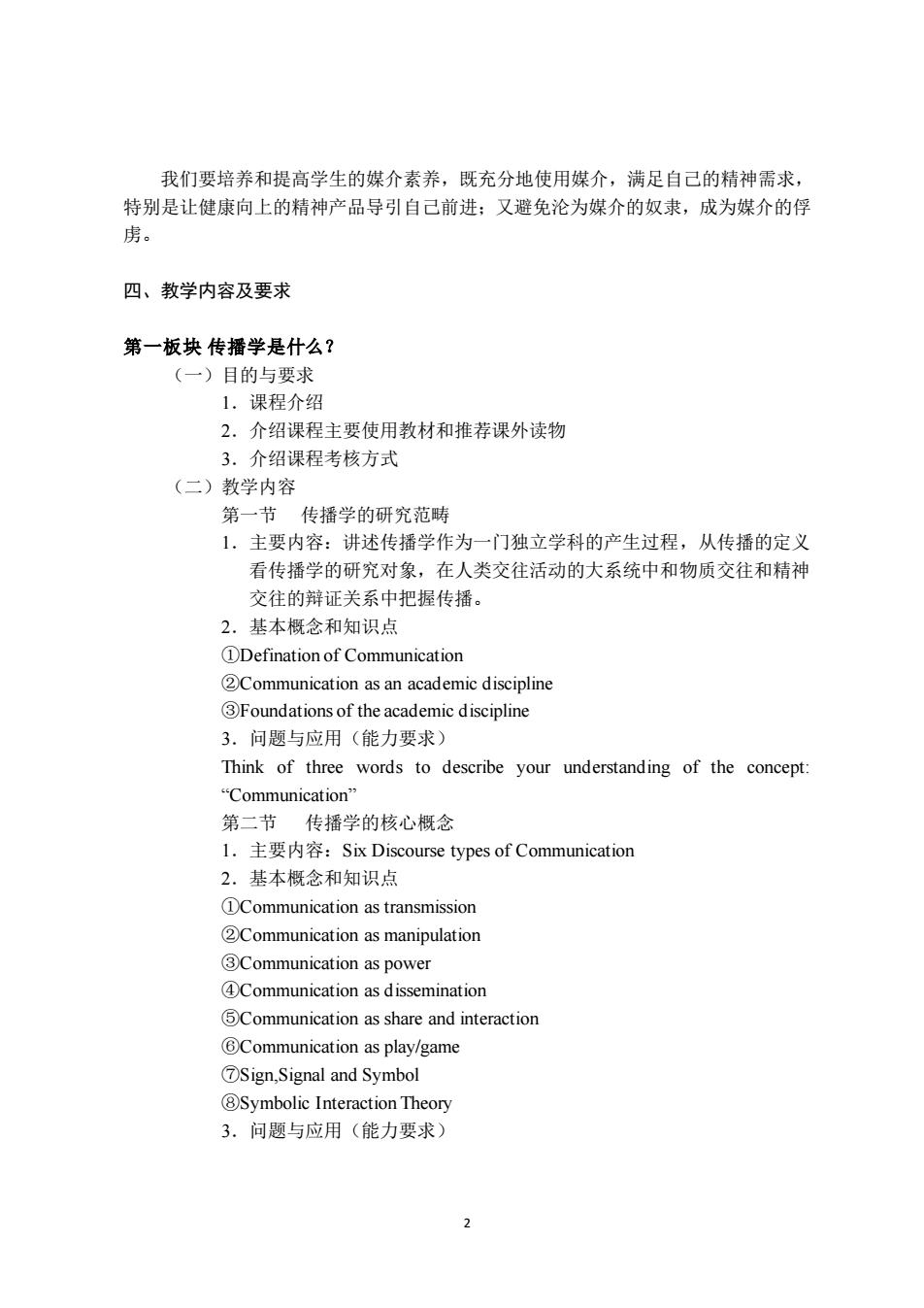
我们要培养和提高学生的媒介素养,既充分地使用媒介,满足自己的精神需求, 特别是让健康向上的精神产品导引自己前进:又避免沦为媒介的奴隶,成为媒介的俘 虏。 四、教学内容及要求 第一板块传播学是什么? (一)目的与要求 1.课程介绍 2.介绍课程主要使用教材和推荐课外读物 3,介绍课程若核方式 (二)教学内容 第一节传播学的研究范畴 1.主要内容:讲述传播学作为一门独立学科的产生过程,从传播的定义 看传播学的研究对象,在人类交往活动的大系统中和物质交往和精神 交往的辩证关系中把握传播。 2.基本概念和知识点 DDefination of Communication Communication as an academic discipline 3Foundations of the academic discipline 3.问题与应用(能力要求) Think of three words to describe your understanding of the concept: Communication” 第二节传播学的核心概念 L.主要内容:Six Discourse types of Communication 2.基本概念和知识点 DCommunication as transmission (2Communication as manipulation Communication as power (Communication as dissemination Communication as share and interaction 6Communication as play/game Sign,Signal and Symbol 8Svmbolic Interaction Theory 3.问题与应用(能力要求》 2
2 我们要培养和提高学生的媒介素养,既充分地使用媒介,满足自己的精神需求, 特别是让健康向上的精神产品导引自己前进;又避免沦为媒介的奴隶,成为媒介的俘 虏。 四、教学内容及要求 第一板块 传播学是什么? (一)目的与要求 1.课程介绍 2.介绍课程主要使用教材和推荐课外读物 3.介绍课程考核方式 (二)教学内容 第一节 传播学的研究范畴 1.主要内容:讲述传播学作为一门独立学科的产生过程,从传播的定义 看传播学的研究对象,在人类交往活动的大系统中和物质交往和精神 交往的辩证关系中把握传播。 2.基本概念和知识点 ①Defination of Communication ②Communication as an academic discipline ③Foundations of the academic discipline 3.问题与应用(能力要求) Think of three words to describe your understanding of the concept: “Communication” 第二节 传播学的核心概念 1.主要内容:Six Discourse types of Communication 2.基本概念和知识点 ①Communication as transmission ②Communication as manipulation ③Communication as power ④Communication as dissemination ⑤Communication as share and interaction ⑥Communication as play/game ⑦Sign,Signal and Symbol ⑧Symbolic Interaction Theory 3.问题与应用(能力要求)
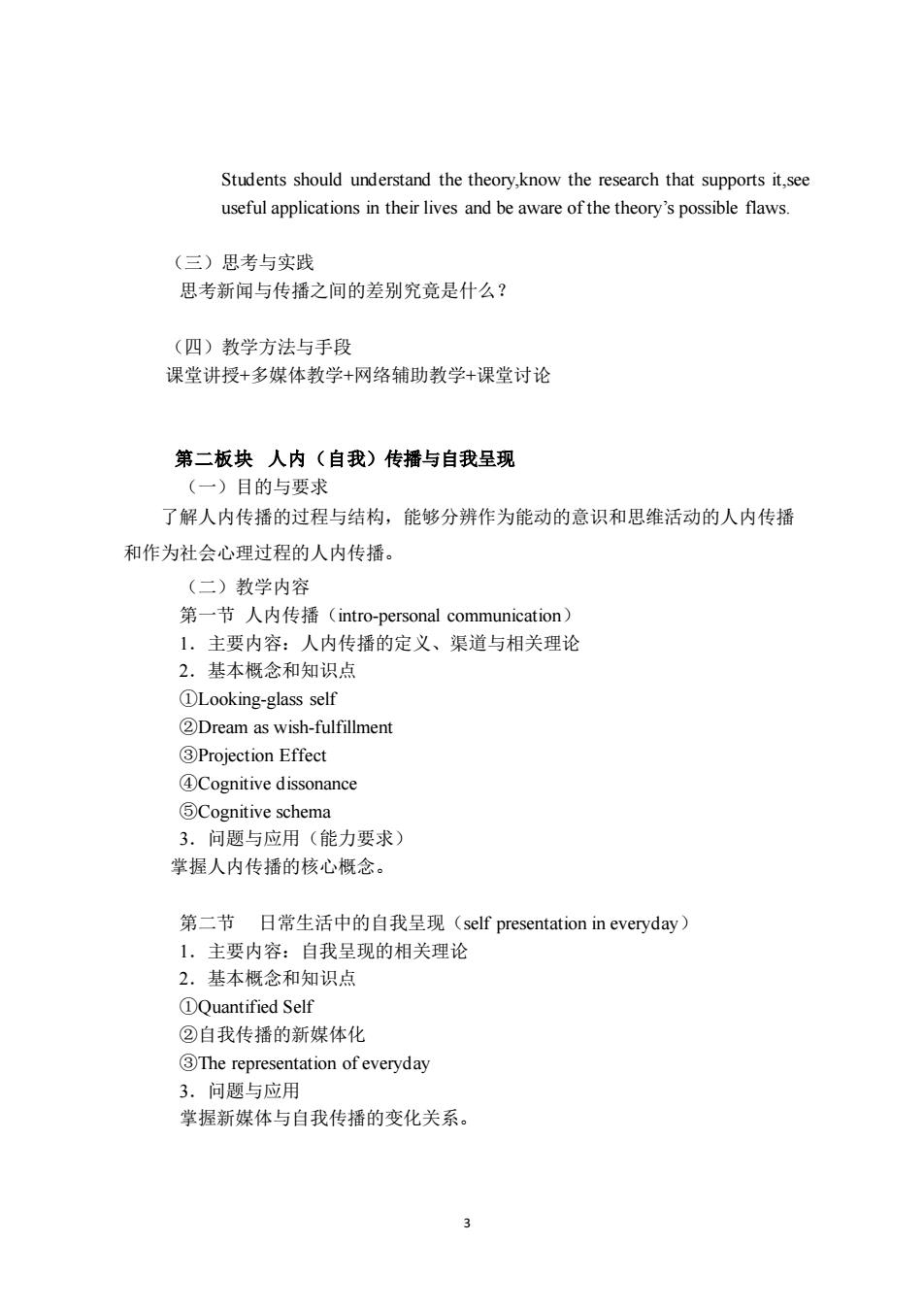
Students should understand the theory know the research that supports it.see useful applications in their lives and be aware of the theory's possible flaws. (三)思考与实践 思考新闻与传播之间的差别究竞是什么? (四)教学方法与手段 课堂讲授+多媒体教学+网络辅助教学+课堂讨论 第二板块人内(自我)传播与自我呈现 (一)目的与要求 了解人内传播的过程与结构,能够分辨作为能动的意识和思维活动的人内传播 和作为社会心理过程的人内传播。 (二)教学内容 第一节人内传播(intro-perso al communication 1,主要内容:人内传播的定义、渠道与相关理论 2.基本概念和知识点 ①Looking-glass self Dream as wish-fulfillmen ③Projection Effect Cognitive dissonance ⑤Cognitive schema 3.问题与应用(能力要求 掌握人内传播的核心概念。 第二节日常生活中的自我呈现(self presentation in everyday) 1,主要内容:自我呈现的相关理论 2.基本概念和知识点 ①Quantified Self ②自我传播的新媒体化 3The representation of everyday 3。问题与应用 掌握新媒体与自我传播的变化关系。 3
3 Students should understand the theory,know the research that supports it,see useful applications in their lives and be aware of the theory’s possible flaws. (三)思考与实践 思考新闻与传播之间的差别究竟是什么? (四)教学方法与手段 课堂讲授+多媒体教学+网络辅助教学+课堂讨论 第二板块 人内(自我)传播与自我呈现 (一)目的与要求 了解人内传播的过程与结构,能够分辨作为能动的意识和思维活动的人内传播 和作为社会心理过程的人内传播。 (二)教学内容 第一节 人内传播(intro-personal communication) 1.主要内容:人内传播的定义、渠道与相关理论 2.基本概念和知识点 ①Looking-glass self ②Dream as wish-fulfillment ③Projection Effect ④Cognitive dissonance ⑤Cognitive schema 3.问题与应用(能力要求) 掌握人内传播的核心概念。 第二节 日常生活中的自我呈现(self presentation in everyday) 1.主要内容:自我呈现的相关理论 2.基本概念和知识点 ①Quantified Self ②自我传播的新媒体化 ③The representation of everyday 3.问题与应用 掌握新媒体与自我传播的变化关系

第三板块人际传播(inter-personal communication) (一)目的与要求 了解人际传播的动机,人际传播的特点和社会功能人际传播与自我表达之间的关 系。探究人际传播在新媒体和移动互联传播情境下出现的新发展。 (二)教学内容 1.主要内容:人际传播的定义、渠道与相关理论 2.基本概念和知识点 DAThree-Dimensional Theory of Interpersonal 2Social Exchange Theory Communication Accommodation Theory 4Face-negotiation Theory Listening and Interaction 3.问题与应用 思考:我们为什么需要人际传播? 第四板块组织传播(Organizational communication) (一)目的与要求 学习群体的概念及其类型,群体的社会功能和意义,了解群体传播与群体意识之 间的关系,以及群体规范在群体传播中的作用。学习组织内、外传播的形态与机制。 五、群体压力与趋同心理 (二)教学内容 1,主要内容:组织传播的定义、渠道与相关理论 2.基本概念和知识点 ①Group think ②Group Pressure ③The pyramid of needs ④The concept of the“Crowd'i ⑤collective behavior 3.问题与应用 思考:什么是乌合之众?关于这个理论有什么问题?集合行为的发生条件特殊 传播机制是什么?
4 第三板块 人际传播(inter-personal communication) (一)目的与要求 了解人际传播的动机,人际传播的特点和社会功能人际传播与自我表达之间的关 系。探究人际传播在新媒体和移动互联传播情境下出现的新发展。 (二)教学内容 1.主要内容:人际传播的定义、渠道与相关理论 2.基本概念和知识点 ①A Three-Dimensional Theory of Interpersonal ②Social Exchange Theory ③Communication Accommodation Theory ④Face-negotiation Theory ⑤Listening and Interaction 3.问题与应用 思考:我们为什么需要人际传播? 第四板块 组织传播(Organizational communication) (一)目的与要求 学习群体的概念及其类型,群体的社会功能和意义,了解群体传播与群体意识之 间的关系,以及群体规范在群体传播中的作用。学习组织内、外传播的形态与机制。 五、群体压力与趋同心理 (二)教学内容 1.主要内容:组织传播的定义、渠道与相关理论 2.基本概念和知识点 ①Group think ②Group Pressure ③The pyramid of needs ④The concept of the“Crowd” ⑤collective behavior 3.问题与应用 思考:什么是乌合之众?关于这个理论有什么问题?集合行为的发生条件特殊 传播机制是什么?
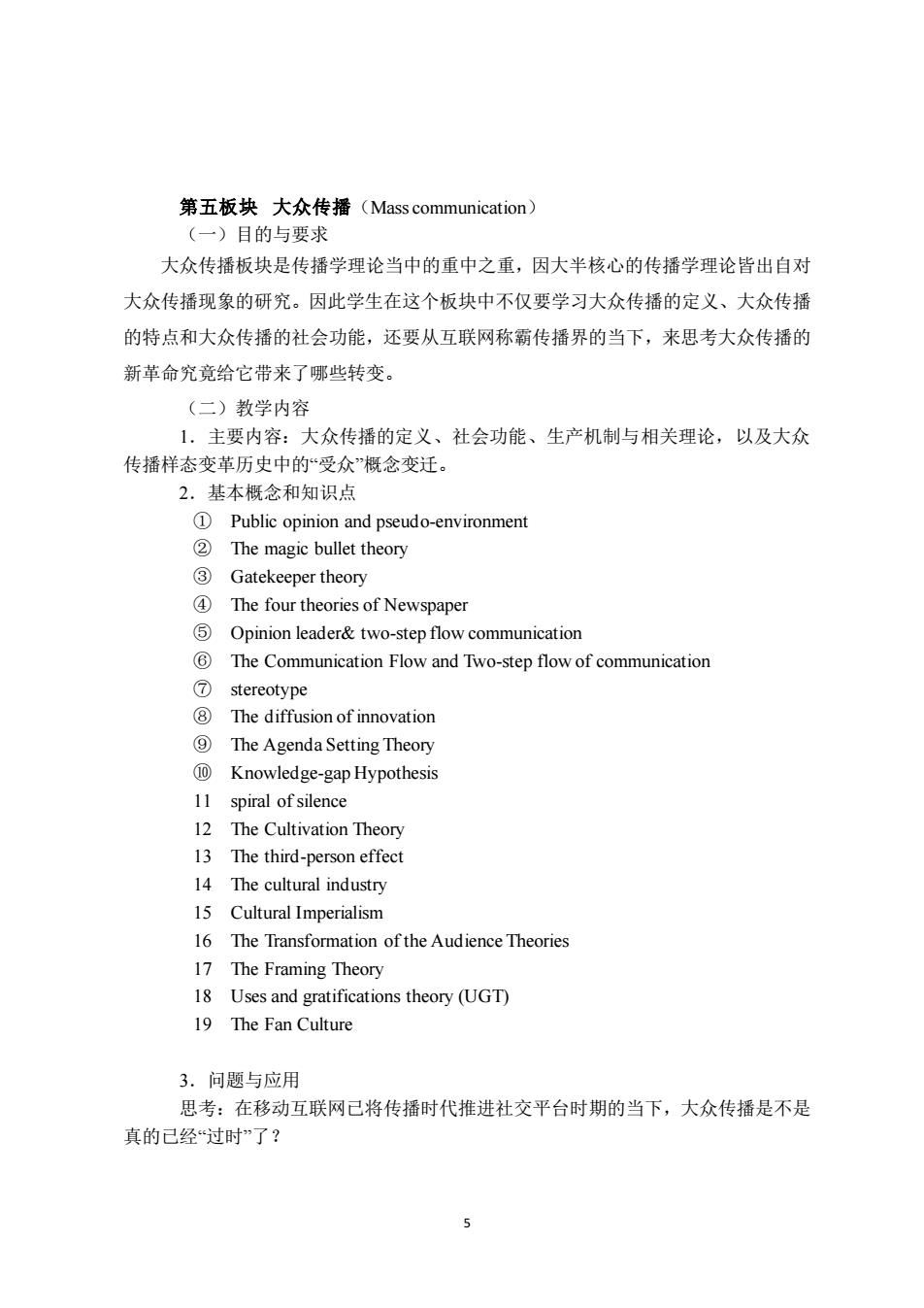
第五板块大众传播(Mass communication) (一)目的与要求 大众传播板块是传播学理论当中的重中之重,因大半核心的传播学理论皆出自对 大众传播现象的研究。因此学生在这个板块中不仅要学习大众传播的定义、大众传播 的特点和大众传播的社会功能,还要从互联网称霸传播界的当下,来思考大众传播的 新革命究竟给它带来了哪些转变。 (二)教学内容 1.主要内容:大众传播的定义、社会功能、生产机制与相关理论,以及大众 传播样态变革历史中的受众”概念变迁。 2.基本概念和知识点 1 Public opinion and pseudo-environment 2 The magic bullet theory ③Gatekeeper theory 4 The four theories of Newspaper 5 Opinion leader&two-step flow communication The Communication Flow and Two-step flow of communication ⑦stereotype The diffusion of innovation The Agenda Setting Theory 1 Knowledge-gap Hypothesis 11 spiral of silence 12 The Cultivation Theory 13 The third-person effect 14 The cultural industry 15 Cultural Imperialism 16 The Transformation of the AudienceTheories 17 The Framing Theory 18 Uses and gratifications theory (UGT) 19 The fan culture 3.问题与应用 思考:在移动互联网己将传播时代推进社交平台时期的当下,大众传播是不是 真的己经“过时”了?
5 第五板块 大众传播(Mass communication) (一)目的与要求 大众传播板块是传播学理论当中的重中之重,因大半核心的传播学理论皆出自对 大众传播现象的研究。因此学生在这个板块中不仅要学习大众传播的定义、大众传播 的特点和大众传播的社会功能,还要从互联网称霸传播界的当下,来思考大众传播的 新革命究竟给它带来了哪些转变。 (二)教学内容 1.主要内容:大众传播的定义、社会功能、生产机制与相关理论,以及大众 传播样态变革历史中的“受众”概念变迁。 2.基本概念和知识点 ① Public opinion and pseudo-environment ② The magic bullet theory ③ Gatekeeper theory ④ The four theories of Newspaper ⑤ Opinion leader& two-step flow communication ⑥ The Communication Flow and Two-step flow of communication ⑦ stereotype ⑧ The diffusion of innovation ⑨ The Agenda Setting Theory ⑩ Knowledge-gap Hypothesis 11 spiral of silence 12 The Cultivation Theory 13 The third-person effect 14 The cultural industry 15 Cultural Imperialism 16 The Transformation of the Audience Theories 17 The Framing Theory 18 Uses and gratifications theory (UGT) 19 The Fan Culture 3.问题与应用 思考:在移动互联网已将传播时代推进社交平台时期的当下,大众传播是不是 真的已经“过时”了?

五、各教学环节学时分配 教学环 节 学 其他 教学时数 趣课 实验 实习 课 计 课程内容 第一板块 5 第二板块 第三板块 第四板块 第五板块 4 合计 48 六、课程考核 (一)考核方式:考试 (二)成绩构成 平时成绩占比:40%期末考试占比:60% (三)成绩考核标准 平时成绩的重要考核标准是,学生们会被要求结合舆论及时事做课堂报告 七、推荐教材和教学参考资源 1.教材:郭庆光著,《传播学教程(第二版)》,北京:中国人民大学出版社,2011 年 2.刘海龙:《宜传:观念、话语及其正当性》,北京:中国大百科全书出版社,2013 年。 3.新闻自由委员会:《一个自由而负责任的新闻界》,北京:中国人民大学出版社, 2004年。 4.詹姆斯凯瑞(美):《作为文化的传播:“媒介与社会”论文集》,北京:华夏出 版社,2005年。 6
6 五、各教学环节学时分配 教学环 节 教学时数 课程内容 讲 课 习 题 课 讨 论 课 实验 实习 其他 教学 环节 小 计 第一板块 4 1 5 第二板块 4 1 5 第三板块 4 1 5 第四板块 4 1 5 第五板块 24 4 28 合计 48 六、课程考核 (一)考核方式:考试 (二)成绩构成 平时成绩占比: 40% 期末考试占比:60% (三)成绩考核标准 平时成绩的重要考核标准是,学生们会被要求结合舆论及时事做课堂报告 七、推荐教材和教学参考资源 1. 教材:郭庆光著,《传播学教程(第二版)》,北京:中国人民大学出版社,2011 年。 2. 刘海龙:《宣传:观念、话语及其正当性》,北京:中国大百科全书出版社,2013 年。 3. 新闻自由委员会:《一个自由而负责任的新闻界》,北京:中国人民大学出版社, 2004 年。 4. 詹姆斯·凯瑞(美):《作为文化的传播:“媒介与社会”论文集》,北京:华夏出 版社,2005 年
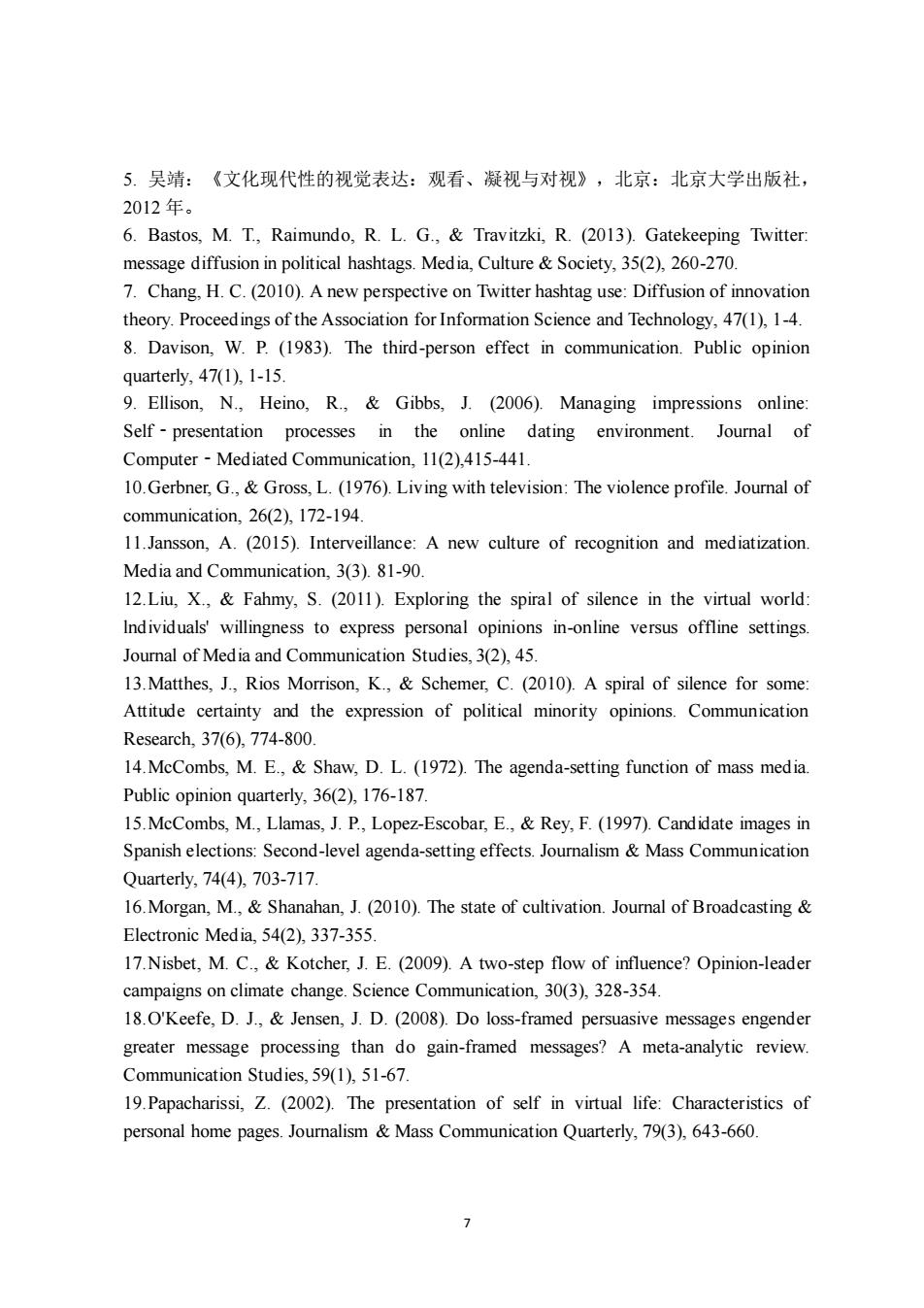
5.吴靖:《文化现代性的视觉表达:观看、凝视与对视》,北京:北京大学出版社, 2012年。 6.Bastos,M.T.,Raimundo,R.L.G.,&Travitzki,R.(2013).Gatekeeping Twitter message diffusion in political hashtags.Media,Culture&Society,35(2),260-270. 7.Chang.H.C.(2010).A new perspective on Twitter hashtag use:Diffusion of innovation theory.Proceedings of the Association for Information Science and Technology,47(1),1-4. 8.Davison,W.P.(1983).The third-person effect in communication.Public opinion quarterly,47(1),1-15. 9.Ellison,N.,Heino,R.,&Gibbs,J.(2006).Managing impressions online Self-presentation processes in the online dating environment.Journal of Computer-Mediated Communication,11(2),415-441. 10.Gerbner,G.,&Gross,L.(1976).Living with television:The violence profile.Journal of communication,26(2),172-194. 11.Jansson,A.(2015).Interveillance:A new culture of recognition and mediatization. Media and Communication,3(3).81-90. 12.Liu,X.,Fahmy,S.(2011).Exploring the spiral of silence in the virtual world: Individuals'willingness to express personal opinions in-online versus offline settings Journal of Media and Communication Studies,3(2),45. 13.Matthes,J.Rios Morrison,K.,&Schemer,C.(2010).A spiral of silence for some: Attitude certainty and the expression of political minority opinions.Communication Research,376),774-800. 14.McCombs,M.E.,&Shaw,D.L.(1972).The agenda-setting function of mass media. Public opinion quarterly,36(2),176-187 15.McCombs,M.,Llamas,J.P.,Lopez-Escobar,E..&Rey,F.(1997).Candidate images in Spanish elections:Second-level agenda-setting effects.Joumalism&Mass Communication Quarterly,744),703-717. 16.Morgan,M.,Shanahan,J.(2010).The state of cultivation.Journal of Broadcasting Electronic Media,54(2),337-355. 17.Nisbet,M.C.,&Kotcher,J.E.(2009).A two-step flow of influence?Opinion-leader campaigns on climate change.Science Communication,30(3),328-354. 18.O'Keefe,D.J.&Jensen,J.D.(2008).Do loss-framed persuasive messages engender greater message processing than do gain-framed messages?A meta-analytic review Communication Studies,59(1),51-67. 19.Papacharissi,Z.(2002).The presentation of self in virtual life:Characteristics of personal home pages.Journalism Mass Communication Quarterly,79(3),643-660
7 5. 吴靖:《文化现代性的视觉表达:观看、凝视与对视》,北京:北京大学出版社, 2012 年。 6. Bastos, M. T., Raimundo, R. L. G., & Travitzki, R. (2013). Gatekeeping Twitter: message diffusion in political hashtags. Media, Culture & Society, 35(2), 260-270. 7. Chang, H. C. (2010). A new perspective on Twitter hashtag use: Diffusion of innovation theory. Proceedings of the Association for Information Science and Technology, 47(1), 1-4. 8. Davison, W. P. (1983). The third-person effect in communication. Public opinion quarterly, 47(1), 1-15. 9. Ellison, N., Heino, R., & Gibbs, J. (2006). Managing impressions online: Self‐presentation processes in the online dating environment. Journal of Computer‐Mediated Communication, 11(2),415-441. 10.Gerbner, G., & Gross, L. (1976). Living with television: The violence profile. Journal of communication, 26(2), 172-194. 11.Jansson, A. (2015). Interveillance: A new culture of recognition and mediatization. Media and Communication, 3(3). 81-90. 12.Liu, X., & Fahmy, S. (2011). Exploring the spiral of silence in the virtual world: lndividuals' willingness to express personal opinions in-online versus offline settings. Journal of Media and Communication Studies, 3(2), 45. 13.Matthes, J., Rios Morrison, K., & Schemer, C. (2010). A spiral of silence for some: Attitude certainty and the expression of political minority opinions. Communication Research, 37(6), 774-800. 14.McCombs, M. E., & Shaw, D. L. (1972). The agenda-setting function of mass media. Public opinion quarterly, 36(2), 176-187. 15.McCombs, M., Llamas, J. P., Lopez-Escobar, E., & Rey, F. (1997). Candidate images in Spanish elections: Second-level agenda-setting effects. Journalism & Mass Communication Quarterly, 74(4), 703-717. 16.Morgan, M., & Shanahan, J. (2010). The state of cultivation. Journal of Broadcasting & Electronic Media, 54(2), 337-355. 17.Nisbet, M. C., & Kotcher, J. E. (2009). A two-step flow of influence? Opinion-leader campaigns on climate change. Science Communication, 30(3), 328-354. 18.O'Keefe, D. J., & Jensen, J. D. (2008). Do loss-framed persuasive messages engender greater message processing than do gain-framed messages? A meta-analytic review. Communication Studies, 59(1), 51-67. 19.Papacharissi, Z. (2002). The presentation of self in virtual life: Characteristics of personal home pages. Journalism & Mass Communication Quarterly, 79(3), 643-660
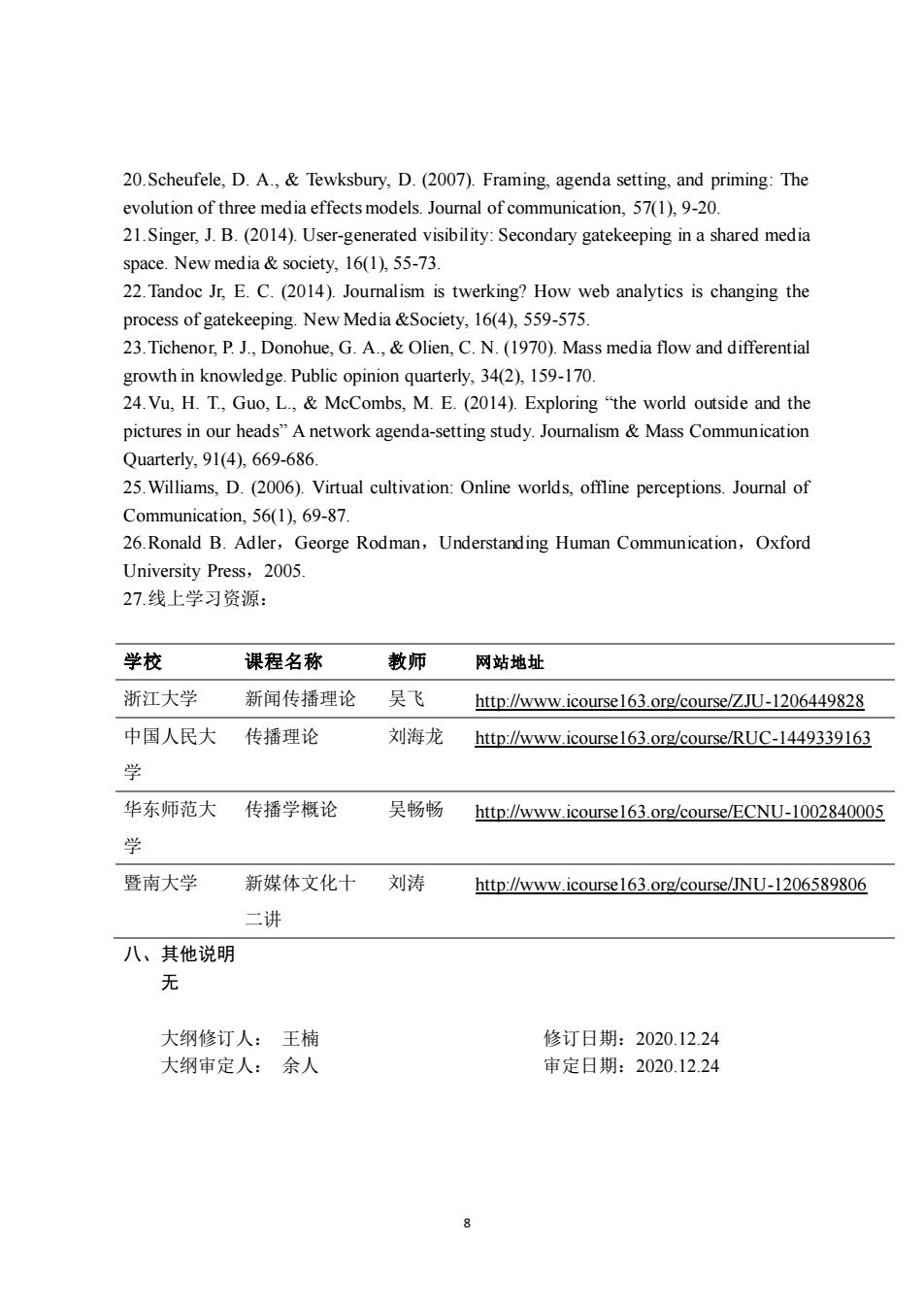
20.Scheufele,D.A.,&Tewksbury,D.(2007).Framing.agenda setting,and priming:The evolution of three media effectsmodels.Joural of communication,57(1),9-20 21.Singer,J.B.(2014).User-generated visibility:Secondary gatekeeping in a shared media space.New media&society,16(1),55-73. 22.Tandoc Jr.E.C.(2014).Journalism is twerking?How web analytics is changing the process of gatekeeping.New Media&Society,16(4),559-575 23.Tichenor,P.J..Donohue,G.A.,Olien,C.N.(1970).Mass media flow and differential growth in knowledge.Public opinion quarterly,34(2),159-170. 24.Vu,H.T.,Guo,L.,McCombs,M.E.(2014).Exploring "the world outside and the pictures in our heads"A network agenda-setting study.Journalism Mass Communication Quarterly,91(4),669-686. 25.Williams,D.(2006).Virtual cultivation:Online worlds,offline perceptions.Journal of Communication,56(1),69-87. 26.Ronald B.Adler,George Rodman,Understanding Human Communication,Oxford University Press,2005. 27.线上学习资源: 学校 课程名称 教师 网站地址 浙江大学新闻传播理论吴飞http://www.icourse163.org/course/ZJU-1206449828 中国人民大传播理论 刘海龙http://www.icourse163.org/course/RUC-1449339163 学 华东师范大传播学概论 吴畅畅http://www.icourse163.org/course/.ECNU-1002840005 学 暨南大学 新媒体文化十 刘涛 http://www.icourse163.org/course/JNU-1206589806 二讲 八、其他说明 无 大纲修订人:王楠 修订日期:2020.1224 大纲审定人:余人 审定日期:2020.12.24
8 20.Scheufele, D. A., & Tewksbury, D. (2007). Framing, agenda setting, and priming: The evolution of three media effects models. Journal of communication, 57(1), 9-20. 21.Singer, J. B. (2014). User-generated visibility: Secondary gatekeeping in a shared media space. New media & society, 16(1), 55-73. 22.Tandoc Jr, E. C. (2014). Journalism is twerking? How web analytics is changing the process of gatekeeping. New Media &Society, 16(4), 559-575. 23.Tichenor, P. J., Donohue, G. A., & Olien, C. N. (1970). Mass media flow and differential growth in knowledge. Public opinion quarterly, 34(2), 159-170. 24.Vu, H. T., Guo, L., & McCombs, M. E. (2014). Exploring “the world outside and the pictures in our heads” A network agenda-setting study. Journalism & Mass Communication Quarterly, 91(4), 669-686. 25.Williams, D. (2006). Virtual cultivation: Online worlds, offline perceptions. Journal of Communication, 56(1), 69-87. 26.Ronald B. Adler,George Rodman,Understanding Human Communication,Oxford University Press,2005. 27.线上学习资源: 1 八、其他说明 无 大纲修订人: 王楠 修订日期:2020.12.24 大纲审定人: 余人 审定日期:2020.12.24 学校 课程名称 教师 网站地址 浙江大学 新闻传播理论 吴飞 http://www.icourse163.org/course/ZJU-1206449828 中国人民大 学 传播理论 刘海龙 http://www.icourse163.org/course/RUC-1449339163 华东师范大 学 传播学概论 吴畅畅 http://www.icourse163.org/course/ECNU-1002840005 暨南大学 新媒体文化十 二讲 刘涛 http://www.icourse163.org/course/JNU-1206589806